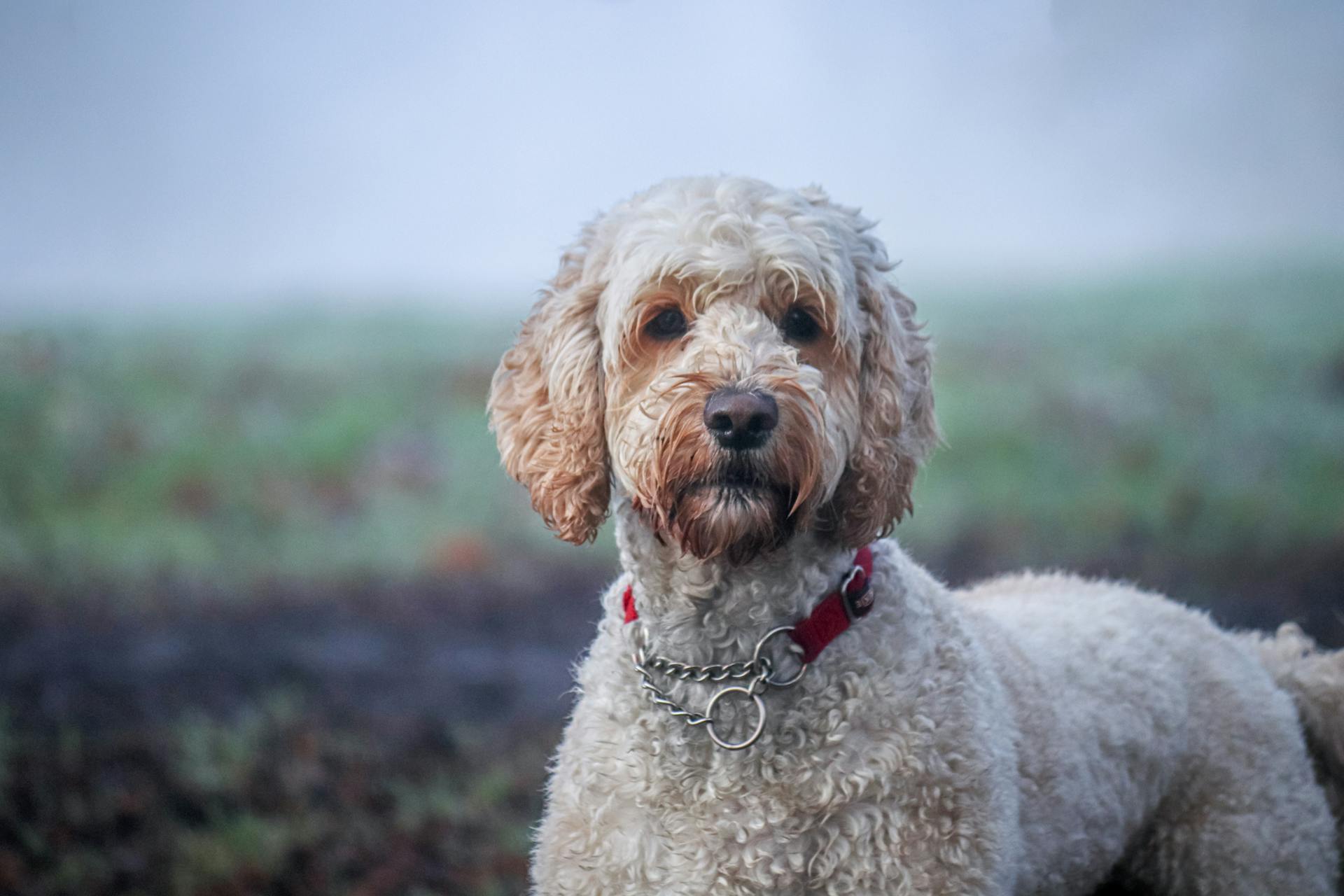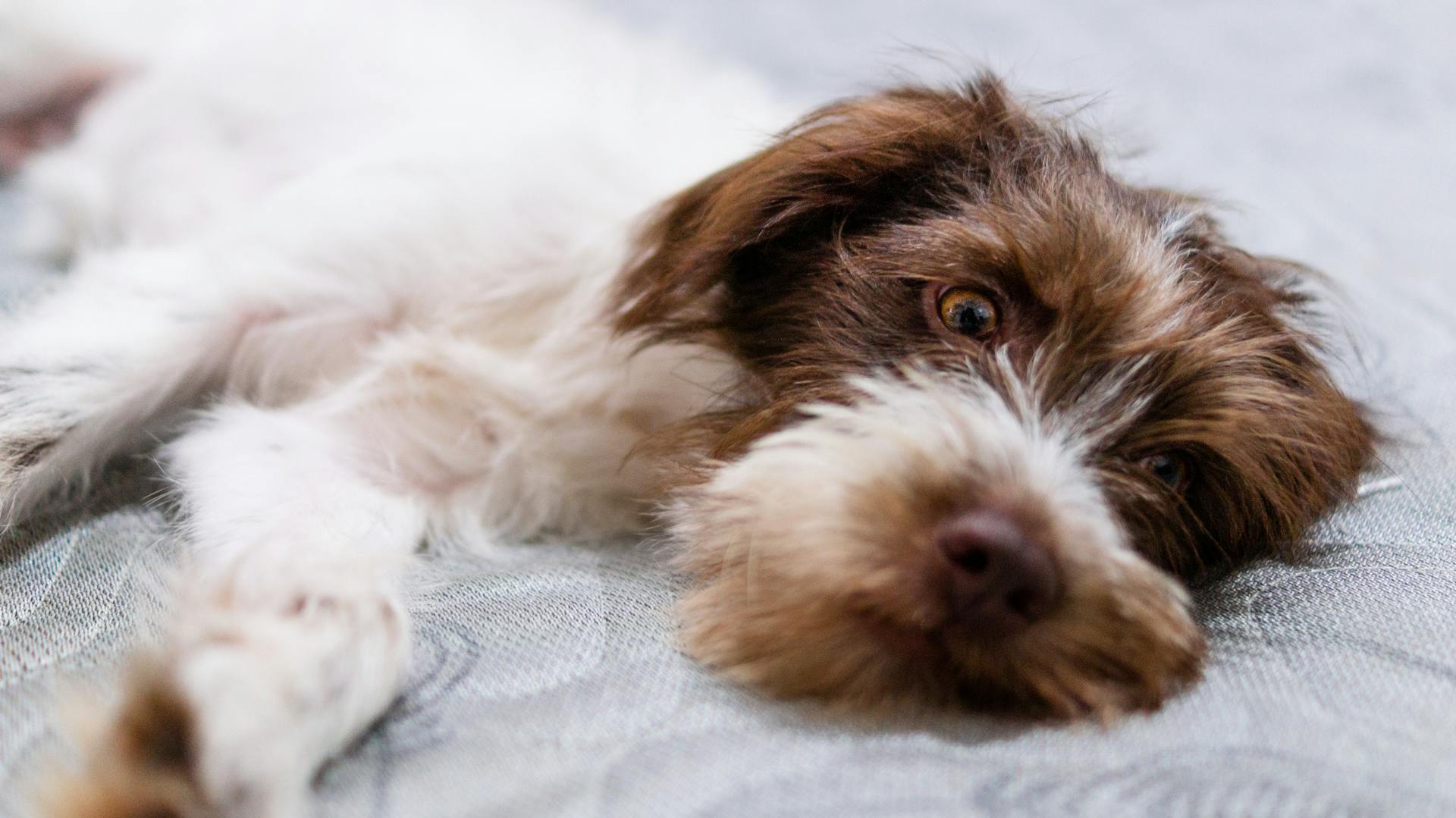
Lab Poodle Mixes are generally medium to large-sized dogs, weighing between 40-80 pounds and standing between 18-24 inches tall. They have a medium-length coat that requires regular grooming to prevent matting and tangling.
Their intelligence and trainability make them a great choice for first-time dog owners, as they are highly responsive to obedience training and can learn quickly.
Origin and History
The Labradoodle's origin story begins with Wally Conron, an Australian guide dog trainer who specialized in breeding hardworking Labradors and Golden Retrievers.
He wanted to create a hypoallergenic guide dog for visually impaired individuals with allergies, which led him to breed Labradors with Poodles in the 1980s.
The first Labradoodle was intentionally bred in 1989 by Wally Conron in Australia.
Wally Conron's goal was to create a dog that combined the intelligence of Poodles with the friendly nature of Labradors.
Many people were initially skeptical of the mixed breed assistance dog, but Wally Conron persevered and proved the Labradoodle's worth over time.
The Poodle's non-shedding trait made them an ideal choice for breeding a hypoallergenic dog with the Labrador's friendly and outgoing personality.
Consider reading: Hypoallergenic Husky Poodle Mix
Temperament and Personality
Labradoodles are loving and affectionate dogs that thrive on human interaction. They're known to be sweet-natured and love to be around their whole family.
Labradoodles are highly sociable and confident around strangers, making them great with children, dogs, and other pets. They'll often be the first to run up to other dogs in the dog park and introduce themselves.
These hybrids are very energetic and need a good amount of space to explore and run around in. They're also just as happy to snuggle up with you on the couch and enjoy a good film.
Labradoodles love people and are amazing with any age range, from young children to seniors. They're also known to happily co-exist with their feline friends.
While they can be energetic, Labradoodles are mostly quiet, keeping barking to a minimum. However, their energy levels can vary based on their generation, with F1s being more energetic than those with more poodle in their blood.
See what others are reading: Dogs That Look like Labradoodles
Labradoodles will often reflect the energy levels of their owner, but they're still descendants of sporting dogs who like having something to do. Whether that means long walks together or playing games in the yard, a Labradoodle will be happiest with any activity they can do with you.
Labradoodles are intelligent dogs that appreciate puzzle toys and will work to get treats. They also need plenty of exercise and mental stimulation to stay happy and healthy.
With proper training and socialization, Labradoodles are not naturally aggressive and make great family pets. They're perfect for active families or individuals who can spend time with them every day.
Labradoodles are adaptable and can thrive in different environments, from apartments to homes with yards. As long as they get enough exercise and mental stimulation, they'll be happy and content.
Explore further: Labradoodles vs Goldendoodles
Appearance and Size
Labradoodles are a unique breed, and their appearance is just as varied as their personalities. They can inherit the curly coat of Poodles or the straight coat of Labrador Retrievers, making each one a one-of-a-kind snowflake.
Their size can also vary greatly, with some Labradoodles reaching up to 24 inches in height, while others are as small as 14 inches. Generally, male Labradoodles tend to be bigger than their female counterparts.
Labradoodles come in a range of coat colors, including black, white, cream, red, chocolate, and mixes of these colors. They also require regular brushing to prevent matting and tangling of their fur.
The International Australian Labradoodle Association has developed a breed standard for Labradoodles, but their appearance can still vary depending on the dogs they were originally bred from.
Labradoodles come in three size variations: miniature, medium, and standard. Here's a breakdown of their size ranges:
Overall, Labradoodles are a diverse breed with a wide range of sizes and coat types, making each one a unique and lovable companion.
Coat and Grooming
Labradoodles come in three main coat types: hairy, wooly, and fleecy. The hairy coat is shorter and wirier, while the wooly coat is dense and soft. The fleecy coat is the most attractive, with long, wavy hair.
The coat type you get will depend on the parents of your Labradoodle. First-generation Labradoodles (puppies with Poodle and Labrador Retriever parents) are more likely to have a hairy coat. Labradoodles with a fleece coat will have long, wavy hair, while those with a wooly coat will have a dense and soft coat.
Labradoodles shed less than other dog breeds, but they still need regular grooming. A weekly brush will help remove loose hairs and dirt, keeping their coat sleek and smelling good.
Labradoodles with a fleece coat may need to have their hair trimmed around their eyes and in between their toes to prevent irritation. You may also want to take them to a professional groomer every so often.
Here are the three main coat types and their characteristics:
Labradoodles with a wooly or fleece coat are generally hypoallergenic and low shedding. However, they still need regular grooming to prevent matting and tangles.
Health and Allergies
Labradoodles can be a great choice for people with allergies because they shed less than other breeds. However, it's essential to note that no dogs are fully hypoallergenic, and Labradoodles will still shed to some extent.
If you're allergic and want a low-shedding breed, the Labradoodle could be a good fit. Their Poodle ancestry makes them a popular choice for those with allergies.
Labradoodles are generally a healthy breed, but they can inherit health conditions from their parent breeds. The most common health issues include hip and elbow dysplasia, eye defects, and allergies.
Here are some health conditions to be aware of in Labradoodles:
- Eye defects
- Allergies
- Hip dysplasia
- Elbow dysplasia
- Epilepsy
- Hypothyroidism
- Diabetes
Are Hypoallergenic?
Labradoodles can be a good choice for people with allergies because they inherit the low-shedding coat of their Poodle parent.
No dogs are fully hypoallergenic, so while Labradoodles may be a better option than other breeds, they still shed at least a little bit.
Labradoodle breeders aimed to combine the friendly personality of a Labrador with the low-shedding coat of a Poodle, making them a viable option for those with allergies.
Conditions

Labradoodles are generally a healthy breed, but like any dog, they can inherit health conditions from their parent breeds. They may be prone to eye defects and allergies.
Hip dysplasia is a common issue in Labradoodles, as it is in their Labrador Retriever parents. Elbow dysplasia is another potential problem.
Epilepsy and hypothyroidism are also possible health concerns for Labradoodles. Diabetes is another condition that may affect some individuals.
Here are some potential health issues to be aware of:
- Eye defects
- Eye defects
- Allergies
- Hip dysplasia
- Elbow dysplasia
- Epilepsy
- Hypothyroidism
- Diabetes
Exercise and Living Needs
Labradoodles need a lot of exercise to burn off their fun-loving energy. They require a couple of long and varied walks a day.
They'll also love a good run around in their local dog park. A Mini Labradoodle will need a little less exercise than Standard Labradoodles, but still lots of playtime and stimulation.
Labradoodles are flexible when it comes to where they live. Smaller dogs, potentially miniature Labradoodles, are better suited for living in smaller homes.
If you live in an apartment or smaller home, make sure you can regularly fit in enough exercise and play for your active pup. A visit to the local dog park every so often can help.
Labradoodles are generally happy to live with other dogs but are also okay when they're left alone for long stretches. They do need exercise, though, so consider investing in a dog walker if you work all day.
Labradoodles can make great hiking partners, and some even like to swim. With positive reinforcement training and meeting their activity needs, they can thrive in any household.
Training a
Training a Labradoodle is a breeze because they're intelligent and eager to please. They're known to make excellent service dogs, particularly therapy and guide dogs.
Labradoodles are highly trainable, but they respond best to positive reinforcement and exciting training methods. They're not fans of being scolded or hearing raised voices.
Early socialization is crucial for Labradoodles, especially with other dogs. Taking them to puppy kindergarten classes and the dog park regularly will help prevent aggression or fears from developing.
Labradoodles are intelligent dogs that inherit their trainability from both Poodles and Labrador Retrievers. They're easy to train and suitable for various tasks, such as guide dogs, therapy dogs, or search and rescue dogs.
The key to training a Labradoodle is patience and hard work. First-time dog owners should be prepared to put in the time and effort to teach their Labradoodle new skills.
Labradoodles are highly energetic and need plenty of opportunities to run, play, and explore. They're perfect for active families or individuals who can provide them with the exercise and mental stimulation they need.
Labradoodles are also highly intelligent and can learn to do a wide range of tasks. With the right training and socialization, they can become valuable companions and assistive dogs.
Cost and Ownership
You can expect to pay between $1,500 and $2,000 for a Labradoodle, depending on where you get it from and the type you want.
Labradoodles from local shelters can cost less, around the lower end of this price range.
F1 Labradoodle puppies, with a Labrador and Poodle as parents, tend to be less expensive than F2 or F3 pups, which have Labradoodles as parents.
Miniature Labradoodles, being extremely cute and sought after, will cost you more than the standard size.
You'll need to budget around $1,500 in the first six months for necessary medical treatment and other expenses for your new pup.
On top of this, you can expect to pay around $3,000 per year for essentials like food, depending on the type you choose.
Recommended read: Pitbull Lab Mix Cost
Cost Estimate
The cost of owning a Labradoodle can add up quickly, but it's essential to understand what you're getting into. You can expect to pay between $1,500 and $2,000 for a Labradoodle from a breeder, although adopting from a shelter can be significantly cheaper.
Here's an interesting read: Labradoodle Bernese Mountain Dog Mix

The cost of a Labradoodle also depends on its type and size. F1 puppies, which have a Labrador and Poodle as parents, tend to be less expensive than F2 or F3 puppies, which have Labradoodles as parents. Miniature Labradoodles, on the other hand, can be more expensive due to their popularity.
During the first six months, you can expect to pay around $1,500 for necessary medical treatment and other expenses. This includes vaccinations, spaying or neutering, and microchipping.
The annual cost of owning a Labradoodle can range from $1,500 to $3,000, depending on the food you choose for your pup. Fresh dog food can be more expensive than kibble, but some owners find it's worth the extra cost for their dog's health and well-being.
Here's a rough breakdown of the costs involved in owning a Labradoodle:
Keep in mind that these costs can vary depending on your location and the specific needs of your Labradoodle.
Discounts

If you're considering bringing a Labradoodle puppy into your family, you'll be happy to know that there are discounts available to make the process more affordable.
There are several groups that qualify for a $100 discount on a Labradoodle puppy, including military personnel, veterans, firefighters, EMTs, police officers, pastors, teachers, and home school parents.
Anyone referred by a Crockett Doodles Forever Home who has adopted a puppy from them is also eligible for a $100 discount.
To receive these discounts, you must request and process them before the adoption is completed on adoption day.
A unique perspective: Golden Retriever Lab Mix Puppies for Adoption
Breeders
Purchasing a pet from a reputable breeder can cost anywhere from $500 to $5,000 or more, depending on the breed and location.
Some breeders may charge extra for services like spaying/neutering, vaccinations, and microchipping.
A responsible breeder will prioritize the health and well-being of their animals, ensuring they are well-socialized and healthy before selling.
You can expect to pay more for a pet that has been certified as being free of genetic disorders.
Breeders often have a waiting list for popular breeds, so be prepared to wait several months or even years for your new pet.
A reputable breeder will provide you with a contract that outlines the terms of the sale, including any guarantees or warranties.
A unique perspective: Lab Weimaraner Mix Breeders
Owning a Miniature
Owning a Miniature Labradoodle can be a wonderful experience. They are fantastic family dogs, making them a great choice for active families with children.
Their gentleness and tolerance mean they do well with kids, and their energetic and playful natures make them fun to be around. However, it's essential to teach your children to be respectful of all dogs.
Miniature Labradoodles are highly trainable and intelligent, which makes them a great choice for families who want a dog that is easy to train and live with. They are also highly active, requiring plenty of opportunities to run, play, and explore to stay happy and healthy.
If you're getting your puppy from a breeder, be sure to meet the parents. This will give you an idea of how your puppy might turn out as they mature, and you can also check the health and cleanliness of their living quarters.
A good breeder will welcome your questions and provide you with plenty of information about your puppy's parents, health, and temperament. Any breeder who is evasive or seems defensive when you ask questions should be avoided.
Every Miniature Labradoodle is unique and beautiful in appearance, with a range of sizes, coat colors, and textures that make almost no two breeds alike.
On a similar theme: Corgi Miniature Poodle Mix
Frequently Asked Questions
What is the downside to a Labradoodle?
Labradoodles require regular exercise to thrive, making them unsuitable for busy owners. Without enough physical activity, they may become restless, destructive, or develop depression.
Is a Labradoodle a good dog?
Labradoodles are ideal family dogs due to their kind, affectionate, and playful nature. They thrive in active families who can provide regular, long walks to match their high energy levels.
Do Labradoodles shed a lot?
Labradoodles from the first generation (F1) can shed significantly, but later generations may be more suitable for those with shedding or allergy concerns.
Are Labradoodles high maintenance?
Yes, Labradoodles are considered high maintenance due to their high energy levels and grooming needs. They require daily exercise, regular grooming, and training to ensure they behave well.
What is a Poodle and Labrador mix called?
A Labradoodle is a crossbreed dog created by combining a Labrador Retriever with a Poodle, often chosen for families with allergy concerns. This unique mix brings together the friendly nature of Labradors and the low-shedding coat of Poodles.
Featured Images: pexels.com


